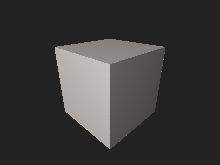Cube
In geometry, a cube or regular hexahedron is a three-dimensional solid object bounded by six congruent square faces, a type of polyhedron.It is an example of many classes of polyhedra: Platonic solid, regular polyhedron, parallelohedron, zonohedron, and plesiohedron.The cube is the three-dimensional hypercube, a family of polytopes also including the two-dimensional square and four-dimensional tesseract.It was associated with the nature of earth by Plato, the founder of Platonic solid.It was used as the part of the Solar System, proposed by Johannes Kepler.A cube is a special case of rectangular cuboid in which the edges are equal in length.[1] Like other cuboids, every face of a cube has four vertices, each of which connects with three congruent lines.[2] Because of such properties, it is categorized as one of the five Platonic solids, a polyhedron in which all the regular polygons are congruent and the same number of faces meet at each vertex., and the space diagonal of a cube is a line connecting two vertices that is not in the same face, formulated as[7] A polyhedron that can pass through a copy of itself of the same size or smaller is said to have the Rupert property.[8] A geometric problem of doubling the cube—alternatively known as the Delian problem—requires the construction of a cube with a volume twice the original by using a compass and straightedge solely.: three axes pass through the cube's opposite faces centroid, six through the cube's opposite edges midpoints, and four through the cube's opposite vertices; each of these axes is respectively four-fold rotational symmetry (0°, 90°, 180°, and 270°), two-fold rotational symmetry (0° and 180°), and three-fold rotational symmetry (0°, 120°, and 240°).[16] The cube is face-transitive, meaning its two squares are alike and can be mapped by rotation and reflection.[17] It is vertex-transitive, meaning all of its vertices are equivalent and can be mapped isometrically under its symmetry.As mentioned above, the cube can be represented as the rectangular cuboid with edges equal in length and all of its faces are all squares.[20] The cube is a plesiohedron, a special kind of space-filling polyhedron that can be defined as the Voronoi cell of a symmetric Delone set.[22] Every three-dimensional parallelohedron is zonohedron, a centrally symmetric polyhedron whose faces are centrally symmetric polygons,[23] An elementary way to construct a cube is using its net, an arrangement of edge-joining polygons constructing a polyhedron by connecting along the edges of those polygons.[24] In analytic geometry, a cube may be constructed using the Cartesian coordinate systems.The cube is Hanner polytope, because it can be constructed by using Cartesian product of three line segments.Its dual polyhedron, the regular octahedron, is constructed by direct sum of three line segments.In other words, the cubical graph is constructed by connecting each vertex of two squares with an edge.A polyhedron is considered equiprojective if, for some position of the light, its orthogonal projection is a regular polygon.As mentioned above, the cube has eight vertices, twelve edges, and six faces; each element in a matrix's diagonal is denoted as 8, 12, and 6.The first column of the middle row indicates that there are two vertices in (i.e., at the extremes of) each edge, denoted as 2; the middle column of the first row indicates that three edges meet at each vertex, denoted as 3.It was named after Plato in his Timaeus dialogue, who attributed these solids with nature.[36] Euclid's Elements defined the Platonic solids, including the cube, and using these solids with the problem involving to find the ratio of the circumscribed sphere's diameter to the edge length.[36] In his Mysterium Cosmographicum, Kepler also proposed the Solar System by using the Platonic solids setting into another one and separating them with six spheres resembling the six planets.[38] The cube can appear in the construction of a polyhedron, and some of its types can be derived differently in the following: The honeycomb is the space-filling or tessellation in three-dimensional space, meaning it is an object in which the construction begins by attaching any polyhedrons onto their faces without leaving a gap.[47] The cube can be constructed with six square pyramids, tiling space by attaching their apices.The Dali cross is a tile space polyhedron,[50][51] which can be represented as the net of a tesseract.



Cube (disambiguation)Platonic solidRegular polyhedronParallelohedronZonohedronPlesiohedronHanner polytopeVerticesSymmetry groupoctahedral symmetryDihedral angledegreesDual polyhedronregular octahedronconvexface-transitiveedge-transitivevertex-transitivenon-compositeGeometryProjectingsphereBranchesEuclideanNon-EuclideanEllipticSphericalHyperbolicNon-Archimedean geometryProjectiveAffineSyntheticAnalyticAlgebraicArithmeticDiophantineDifferentialRiemannianSymplecticDiscrete differentialComplexFiniteDiscrete/CombinatorialDigitalComputationalFractalIncidence Noncommutative geometryNoncommutative algebraic geometryDimensionStraightedge and compass constructionsDiagonalOrthogonalityPerpendicularParallelVertexCongruenceSimilaritySymmetryZero-dimensionalOne-dimensionalsegmentLengthTwo-dimensionalPolygonTriangleAltitudeHypotenusePythagorean theoremParallelogramSquareRectangleRhombusRhomboidQuadrilateralTrapezoidCircleDiameterCircumferenceThree-dimensionalVolumecuboidCylinderDodecahedronIcosahedronOctahedronPyramidTetrahedronTesseractHypersphereGeometersAryabhataAlhazenApolloniusArchimedesAtiyahBaudhayanaBolyaiBrahmaguptaCartanCoxeterDescartesEuclidGromovHilbertHuygensJyeṣṭhadevaKātyāyanaKhayyámLobachevskyManavaMinkowskiMinggatuPascalPythagorasParameshvaraPoincaréRiemannSakabeal-TusiVeblenVirasenaYang Huial-YasaminList of geometerspolyhedron